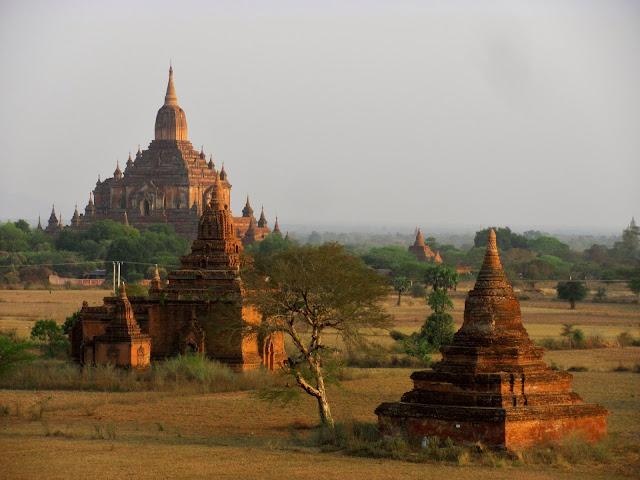As famous as Bagan is for its history, Inle Lake is famous for its natural beauty and people. The 116 square kilometer lake is home to the Intha people, who continue to live in small stilted communities along the lake’s shore. They make their living from the lake by fishing, gathering seaweed, making fabrics from lotus flowers, and gardening. The men row distinctively across the lake, standing at the stern and paddling with one leg wrapped around an oar as they fish with large, hand-woven baskets. It is a way of life we can only imagine is fast-declining, but is still thriving here.
As an introduction to the area we took a boat tour around the lake. While the trip was a little touristy, we enjoyed visiting a nearby market, seeing several of the handicraft shops (including the cigarette rollers and lotus weavers), chatting with the other travelers in our boat, getting up close to fishermen, paddling through stilt houses, and receiving enthusiastic waves from locals busily paddling or motoring across the lake. It was a wonderful way to see the area and a great way to spend Nora’s birthday! That evening we had dinner with a German couple from our boat tour at a local restaurant/bar. It was a fun birthday dinner for Nora, made better by running into two Americans traveling around Myanmar together, dressed as Mario and Luigi. We aren’t sure what the locals were making of their costumes and facial hair, but we thought it was pretty funny.
On our second day here we went on a walk outside of town, through some small villages. The people here, as everywhere in rural Myanmar, were incredibly friendly. Though we had a language barrier, people happily greeted us with a friendly “mingalaba!” and a wave. Our final destination was a winery in the hills where we did a tasting of some of the local wine. It was not the best wine we’d ever had, but it was a fun treat, nonetheless.
The town of Nyaungshwe, where we stayed, had an interesting local market that we liked to browse. It was bustling with locals and full of stands for traditional skirts (longgi), woven shopping bags, produce and meat, and everything your average Burmese person might need. It was also home to some great, cheap food stalls and we ate here more than once, sampling grilled fish from the lake, the Burmese take on Indian roti, and “husband and wife cakes” (mote lin mayar). While we were here the town experienced a terrible fire that took out about half of a block near downtown. It was a chaotic scene with hundreds of bystanders clogging the streets and locals fighting the fire with garden hoses and plastic buckets full of water. By the time the “fire truck” arrived and made its way through the crowds, the fire had nearly burned itself out.Though the mood of the town was decisively nervous, it was amazing to watch locals come together to help put out the fire as quickly as possible and then begin demolishing and rebuilding the next day.
Click on the photo below for our Inle Lake photo album.
As an introduction to the area we took a boat tour around the lake. While the trip was a little touristy, we enjoyed visiting a nearby market, seeing several of the handicraft shops (including the cigarette rollers and lotus weavers), chatting with the other travelers in our boat, getting up close to fishermen, paddling through stilt houses, and receiving enthusiastic waves from locals busily paddling or motoring across the lake. It was a wonderful way to see the area and a great way to spend Nora’s birthday! That evening we had dinner with a German couple from our boat tour at a local restaurant/bar. It was a fun birthday dinner for Nora, made better by running into two Americans traveling around Myanmar together, dressed as Mario and Luigi. We aren’t sure what the locals were making of their costumes and facial hair, but we thought it was pretty funny.
On our second day here we went on a walk outside of town, through some small villages. The people here, as everywhere in rural Myanmar, were incredibly friendly. Though we had a language barrier, people happily greeted us with a friendly “mingalaba!” and a wave. Our final destination was a winery in the hills where we did a tasting of some of the local wine. It was not the best wine we’d ever had, but it was a fun treat, nonetheless.
The town of Nyaungshwe, where we stayed, had an interesting local market that we liked to browse. It was bustling with locals and full of stands for traditional skirts (longgi), woven shopping bags, produce and meat, and everything your average Burmese person might need. It was also home to some great, cheap food stalls and we ate here more than once, sampling grilled fish from the lake, the Burmese take on Indian roti, and “husband and wife cakes” (mote lin mayar). While we were here the town experienced a terrible fire that took out about half of a block near downtown. It was a chaotic scene with hundreds of bystanders clogging the streets and locals fighting the fire with garden hoses and plastic buckets full of water. By the time the “fire truck” arrived and made its way through the crowds, the fire had nearly burned itself out.Though the mood of the town was decisively nervous, it was amazing to watch locals come together to help put out the fire as quickly as possible and then begin demolishing and rebuilding the next day.
Click on the photo below for our Inle Lake photo album.






